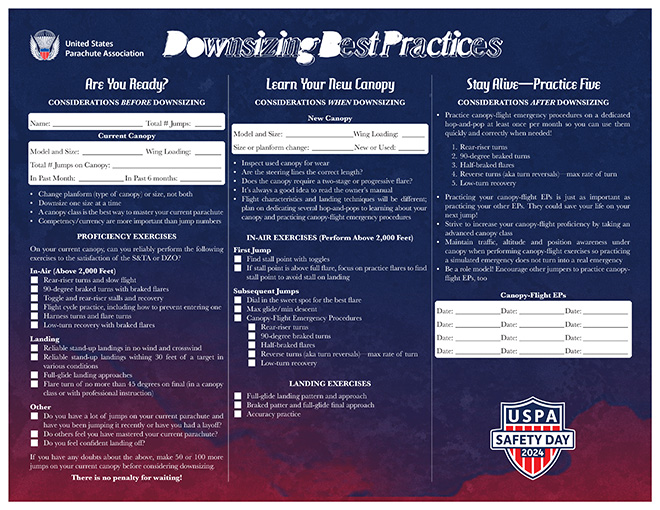Rating Corner | Guiding Jumpers Who Are Downsizing
Downsizing a canopy is a significant step for jumpers, and it comes with increased risks and requires enhanced skills. USPA has developed a Downsizing Best Practices process to help USPA Safety and Training Advisors and Instructors guide jumpers in making informed, safe decisions when considering downsizing. Instructors should emphasize the importance of skill and competency over just the number of jumps or time in the sport. Skydivers often feel that being advised against downsizing is a critique of their ability. Instructors must focus on changing this narrative by highlighting the necessity of mastering one's current parachute before moving to a smaller size or changing their canopy planform.
Downsizing: Best Practices Form
The role of the USPA Downsizing Best Practices form is multifaceted, serving as a crucial tool in guiding and ensuring the safety of skydivers considering a transition to a smaller parachute. Its primary functions include:
1| Self-Assessment and Planning: Initiates a self-assessment for the skydiver, considering factors like total jumps, experience with the current canopy and wing loading.
2| Guided Decision Making: Helps in making informed decisions by outlining factors to consider before downsizing, such as completion of canopy courses.
3| Skill Verification: Lists specific exercises for the skydiver to perform proficiently before considering downsizing.
4| Professional Involvement: Facilitates structured interaction with instructors, drop zone operators or Safety and Training Advisors for assessing readiness.
5| Safety and Risk Management: Ensures safety by requiring a thorough assessment and skill demonstration.
6| Promoting Responsible Progression: Encourages a safety culture, emphasizing skill and proficiency over external pressures.
Psychology of Downsizing: Understanding the Skydiver's Mindset
A critical aspect of an instructor’s role in the downsizing process involves understanding and addressing the psychological factors at play. When skydivers express a desire to downsize, it often comes with a complex mix of ambition, peer influence and a quest for advancement in the sport. Instructors must recognize that a skydiver's request to downsize is not just a technical query; it is often intertwined with their self-image and aspirations as a canopy pilot.
It's common for skydivers to interpret hesitation or advice against immediate downsizing as a negative assessment of their skills. They might internalize this as a suggestion that they are not progressing adequately or that their abilities are underestimated. Instructors need to be keenly aware of these sentiments. They should approach such discussions with sensitivity, affirming the skydiver's accomplishments while emphasizing the importance of safety and skill mastery.
Instructors can address this by reshaping the conversation around downsizing. It's not just about whether a skydiver is ready for a smaller canopy; it's about ensuring they have the necessary control and precision under various conditions. This approach helps shift the focus from quantity of jumps to quality of skills.
Moreover, instructors should foster an environment where patience and gradual progression are celebrated as much as achieving milestones like downsizing. They should encourage skydivers to view mastery of their current canopy as a significant achievement and a crucial step toward safe and responsible downsizing.
By considering the psychology behind the desire to downsize, instructors can guide skydivers more effectively. This involves imparting technical skills and nurturing a mindset where safety and skill development are prioritized over the allure of flying a smaller, faster canopy. Ultimately, this approach helps build a skydiving culture where decisions are made based on competence and confidence rather than ego or external pressures.
Continuous Learning and Mastery: The Journey Beyond Downsizing
The path to downsizing in canopy piloting is not a destination but a journey of continuous learning and mastery. Instructors should emphasize the importance of continuous improvement, focusing on the mastery of each canopy. This approach ensures that canopy pilots develop a deep understanding of their equipment’s unique characteristics and flight dynamics.
Instructors must advocate a mindset where every jump is an opportunity to learn. Setting both short-term and long-term goals for downsizing and overall canopy proficiency must be encouraged. This culture of perpetual learning helps maintain a humble attitude, which is essential for safety and skill development in the sport.
The emphasis is also on decision-making and situational awareness, not just technical ability. Understanding varying weather conditions, managing airspace and being prepared for emergencies are integral parts of this journey. Instructors strive to create a community of well-rounded, safety-conscious skydivers, where mastery is a continuous pursuit beyond the milestone of downsizing.
The role of USPA instructors in guiding canopy pilots through downsizing is crucial. Using the Downsizing Best Practices Form , will help jumpers balance technical skill development with psychological understanding and the importance of continuous learning. Emphasizing safety and competency, instructors help skydivers navigate the complexities of downsizing, ensuring that this progression is as much about mental readiness as it is about physical skill. This approach cultivates a responsible and proficient skydiving community, where every step toward downsizing is taken with wisdom and care.
Ron Bell | D-26863
USPA Director of Safety and Training
12107